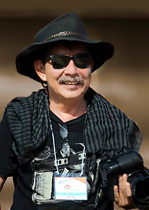The Balangiga Massacre monument
The people of Balangiga, Eastern Samar – about one and a half hour drive away from Tacloban – commemorated the 107th Anniversary of the Balangiga Encounter of September 28, 1901 with the clamor for its unreturned bells resounding in almost muted silence.
This year’s commemoration program, however, was held on September 30 to coincide with the visit of President Gloria Macapagal-Arroyo at the municipal plaza where the P6-million Balangiga Encounter Monument and Memorial Library designed by National Artist Napoleon Abueva now stands.
As in previous years, hundreds of people flock to Balangiga to witness the commemoration rites of the event in 1901 in which Filipino revolutionaries almost wiped out the entire American detachment posted in the area at the time. In retaliation, the Americans “burned” Samar for six months and took with them the Balangiga church bells as war trophies.
For years, the continuing wish has been for the return of the bells to its original and rightful owner, the Philippines. The Bells of Balangiga which are now at the “Trophy Park” of the Warren Airforce Base in Wyoming, belong to the Church for the use of the people of Balangiga.
Some time ago, representation was made by the Philippine delegation led by former President Fidel Ramos and Ambassador Raul Rabe, supported by some American legislators, for the return of the bells. This resulted in a compromise position, namely, to have the two bells recast and then to give one original and one replica to each country. This is the position that is accepted and supported by the members of the United States Catholic Conference (USCC). The Diocese of Borongan, with much reluctance, agreed to this arrangement.
However, to this date, the Balangiga Bells remain in Wyoming.
(Reference: PIA Press Release 2008/09/28)
The Balangiga Encounter Monument and Memorial Library, inaugurated on its 102nd anniversary on Sept 28, 2003:
The renovated Balangiga Church of today:











Gosh Gerry,
You generate lyrics in your pictures and melodies in your words! Thanks for the historical journey and really looking forward to shake your hand.
Thank you Mr. Roger for your kind words! It would be a real pleasure to meet up with you soon!
its a shame that the collection in the museum under the monument has been relegated to only a hand full now…. such history here to be studied and many of us still are in the dark about our own past
Is it really a monument to the massacre or a monument to the people’s fight for freedom? Freedom!!! Yes!!! Freedom from tyrants both foreign and local!!! It’s an ongoing battle. Thanks Gerry, for sharing these pictures.
gerry, thanks for the photos again
I’m sorry [some] people seem to think the Americans were tyrant. My great-great-great uncle fled Germany fleeing oppression there and settled in America. He joined the army at 24 and served with honor in the Spanish-American war, the China Relief Expedition, and the Phillippine-American War. He was held in high regards by his family, my great grandad even named in part after him. He was slaughtered at Balangiga and his body burned by the rebels, so it was never returned to his family. Was he a tyrant? No. The Americans were certainly wrong in burning Samar afterwards no doubt about it, but are we proud of it? No. Did we build monuments celebrating it? No. I am dismayed that the Filipinos built a monument depicting the slaughter of American soldiers, who did nothing of consequence to the local populace, and in fact were requested to be there by the mayor of Balangiga. I believe that the Americans should return the bells to Balangiga, on the condition that a monument be erected alongside the Filipino monument in memory of the American soldiers who, before they were killed, made a heroic stand in the service of their country. Pvt. August Porczeng and his comrades deserve far better than the bum deal they’re getting now.
By the way, the Filipinos lost that war. The Americans granted them independence in 1946 not in any part due to this war. Also, the Americans were never tyrannical towards the Filipinos before the insurrection, nor were they after it was over.
oh, come on, you just have to admit that really that was the first time Americans suffered and lost immensely – at the Balangiga Massacre.
Just like you, I myself is a descendant of one of the Balngigan-ons who fought against the Americans. I am a great, great grand-niece of Capt. Valeriano Abanador.
You really have to do more research on what really happened. Even Ms Jean Wall, the daughter of Pvt. Adolf Gamlim (one of the survivors), has to come to Balangiga and did her research for years and years to further understand what really had happened.
In response to what Porceng has said:
Although the Americans (especially those of today) are generally not tyrannical, the Americans in the Philippines during the Philippine-American war were tyrannical. I know my Philippine History pretty well, hence I know that the Americans at that time (although brought education and other beneficial things to this country) also brought suffering, deception, and death to many Filipinos. From the very beginning, they deceived Emilion Aguinaldo into thinking that they did NOT want to colonize the Philippines, but simply wanted to help us from the Spanish. But as everyone may know, this did not happen (which is why several battles and massacres, such as the Balangiga massacre, took place).
I hope you realize that the Philippines went through a lot of suffering because of the tyrannical Americans during the late 1800’s and early 1900’s. And the reason why there is now a monument of the slaughter of the Americans in Balangiga is because we are proud of the Filipinos who stood up against these more powerful and more properly war-equipped Americans, who cut off the Filipinos from their food, land, and other resources. They were merely fighting for their freedom and rights, which the Americans took away from them AT THAT TIME. This was the Philippines and it was OUR country. We had every right to defend it from foreign invaders who abused our people.
That is my opinion, of course.
As an American-Filipino I was stunned to see how history once again showed the arrogance of the United States of America. I love this country (America ) and always have I known that in any place of the world people can come together and support openly anything or any idea. I find it a blessing to have learned about some my true heritage. I just wish the rest of the world would find out the truth and come to accept it. It will be only through acceptance of the past that will allow Americans, Filipinios, and mankind to create a better future.
In response to proudlyfillipino-
Tyrants who abused your people?!! Come off it. The phillipines were treated way better by Americans than the Spanish. Also we did not deceive Aguinaldo about how we wanted to colonize the Phillipines, it was all in black and white with our treaty with Spain! As far as atrocities go your side comitted just as many as ours, and all of them, on both sides were isolated incidents that were not ordered by higher ups with exceptions of the Balangiga Massacre (your atrocity) and the Samar Massacre (our atrocity). The officers who ordered and carried out the Samar Massacre were shunned by their fellow officers for the rest of their lives! They were considered fiends and certainly never had any monuments built to them! As far as civilians suffering that happens in war. “war is hell and it cannot be refined” is a true quote. As far as rights and freedom, after the war the Phillipines were treated very very fairly and their citizens enjoyed almost all the rights US citizens had at the time. In fact the sons of many rebels fought alongside the US against the Japanese so how evil could the Americans have been? Have you ever heard of a war where the local populace didn’t suffer? I’ve studied military history all my life and I haven’t. I just want to honor the memory of simple foot soldiers like August Porczeng. If you really studied history you would know that the Americans were requested to be there by local officials and that his regiment, the 9th infantry never committed any atrocities against the Phillipinos during their entire time there. They were recorded by locals as being friendly towards them and even played games with them on a regular basis! The men of company C were killed simply because they were there. I just want to defend the honor of men like August. If you think men like August, a 24 year old kid from Germany who joined the army simply because he hated his job as a farm hand and admired his brothers who were soldiers, are tyrants simply because they were representatives of a government who from your point of view was evil, you are truly ignorant! That is of course, just my opinion. What matters is now our nations are friends so we should try to overcome our bias, (I admit I am biased but you obviously are as well), and paint an accurate picture of a chapter in our nations’ histories that none of us should be proud of!
Porceng….. I have been studying, and reading the Balangigga action since I was in the US Navy in the Philippines 1974-75…At one time I could tell you the name of every soldier in the detachment, where they were from, and how they died, went missing or survived… They were in my mind like a family to me…. I moved to eastern leyte 2008, and married a girl from Samar… I traveled to Balangigga my first opprotunity 2008, and have made many trips there since then. The town Presidente Pedro Abayan requested american troops to be sent to Balangigga to protect them from the insurectos… The request was granted, Captain Thomas Connell and Co C was selected to go there. Captain Connell was a devout Catholic, and and a big advocate of treating Filipinos with respect, and tolerance… This was used against them by the town Priest, Mayor and police chief who manipulated him into eventually almost disarming his entire company to show trust to the locals, and a strict hands off policy to the women, which allowed Bolos to be smuggled in under dresses of both women, and men dressed like women, carying coffins of children with more bolos inside…..Anyway… you know the history…. the mutilated and burned american bodies were burried in the town plaza, by the relief force that arrived a couple of days later…Pigs later rooted up the remains, and they were reburried deeper, and a fence put around the mass grave to prevent further problems…The Plaza is where the monument has ben errected… Nobody seems really to know where exactly the grave is, but suspect the monument is built right over it… Filipinos say only about 25 locals died in the action, US Army reports say over 250 locals died, but after looking at the fact that the US soldiers were burried in the trench dug for the 250 that were suposidly pulled out and cremated, I believe that 25 is probably correct because of the pigs rooting up the bodies in such a shallow grave….The Army would want the numbers looking like the soldiers did better than they could have, because the deciet, and trechery never gave them a chance to really fight back… bodies X 10 = 250… a Company C Private Denton went missing before the attack, and the Army plays low key and does not like to mention that he was caught later with a Insurrecto leutenants commission in his pocked signed by Vinvinte Lukban, and may have helped in the planning of the attack…. Who knows…. Samar, and Leyte have not changed much in the last hundred or so years…. The bulk of the people are not interested in politics or thier history, they will believe or repeat which is most advantageous to them….. You hear all the horror stories of the Japanese occupation here, but US forces leveled every town in Leyte except Palo, and Tacloban, which they used for the headquarters and provesional government, because of what they percieved as heavy colaboration by the local populance with the Japanese… Leyte, and Billiryn was heaven for the Japanese, and face it, the well off people would lose everthing by fighting the powers that were, and the poor stood nothing to gain…. people in the Philippine american war, or WW2, or now, just want to be left alone to take care of thier families… but there is always a faction that threatens and tries to manipulate them as well… I would love to have your email to discuss more with you, or take photos for you…. Take care dear friend.. Dave
Porceng… do not compare how those US soldiers were treating Filipinos better than the spanish or by the Japanese, the fact and main point is that 12 years old children and older were massacred and died thats all
I also wish to add a few things which I forgot to mention (surprisingly) in my previous (long-winded I’m sure you think) posts:
1. Many Filipinos supported America such as Aguinaldo’s prime minister (whose name escapes me) and the Filipinos who fought in organizations like the Philippine Scouts and the Philippine Constabulary.
2. “The American military was in the Philippines to quell an ‘insurrection’, a rebellion by the native Filipinos opposing American occupation. They were not there to fight a people defending their homeland. This was the basic tenet taught to the American soldiers sent to fight in the islands.”
That is what Americans were taught to believe. Its not completely true in actuality but considering that many Filipinos supported the Americans or at least did not openly oppose them, it contains a certain degree of truth. The Anti-Americans were only part of the population.
3. The men fighting in Company C undoubtedly had more in common with the men who killed them than the men they served. This is true of most fighting men in most wars. My ancestor in particular was a Roman Catholic, which was not that common in the then Protestant dominated US but was THE religion in the Philippines. Also he came from a culture – Polish – that was oppressed in as harsh (and possibly harsher) manner than the Philippines. I’m sure that some think that’s crap, but for example: military takeover of Poland (many times), Holocaust (millions of Poles killed), Kulturkampf (stamping out of Polish culture and religion by Bismark and what ultimately drove my family to America).
4. I recently stumbled across an old newspaper article in my basement regarding the death of August. It tells how the wounded men of Company C, August included, were believed by Army intelligence (reliable?) to be tortured and burned alive by the rebels, a statement supported by the fact that the men’s remains were never found. And a monument was built to that? Murder?
I’m proud of my ancestor’s service as I am proud of any man who fights in 3 wars and dies for their adopted country. (Note: Neither he nor the men of the US company were ever associated with a war crime). However, I sure as hell am NOT proud of the way American soldiers slaughtered “every man over the age of 10” in retaliation for the deaths of the men of Company C, as any human being and Catholic should be. I’m not trying to excuse the actions of those wretches like General Smith. BUT I do want to defend the honor of brave, hardworking American soldiers like August, who – though some may say their cause was not the most righteous (I’m sure they’d say the same about the Filipinos) – served with honor and dignity. I have recently found out of a plan to return the bells on the condition a monument be erected to the men of Company C, whose bravery has never been recognized and is remembered only by half-crazed family members and historians like me. I whole-heartedly support this plan as a Catholic, American and descendant of an American soldier. If anyone reading this visits that monument, please remember what the war cost both sides.
I hope that the Balangiga Bells will be returned to the historic town of Balangiga..It belongs to our country, not in the state of Wyoming..
Great post! I didn’t realize that there was such a wonderful memorial until now. Thanks for posting photos of it.
Just for your information, one of the three bells is currently located at the 2nd Infantry Division’s museum at Camp Red Cloud in Uijongbu, South Korea.
Our Filipino church based in Covina California will be traveling by land to Oshkosh, Wisconsin and we will probably visit Cheyenne, Wyoming to view the bells. It would be eerie and eye-opening for our kids who are born in this country. I will brief them of this piece of history.
to porceng:
everything you know about world history and military history is just simply not what it seems to be. what are you talking about americans not being tyrannical to filipinos? do you know the real torture methods these “superior race” americans applied to suspected guerillas? even your own judge james blout who was part of the so-called warren fact-finding commission sent by the U.S. President at that time was dismayed at the sight of these “civilized” american soldiers applying the “water torture” to these filipino civilians. do you get the picture, porceng? read some more, because you probably went to the wrong schools, buddy.